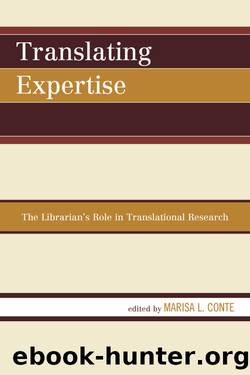Translating Expertise by Conte Marisa L.;

Author:Conte, Marisa L.; [Conte, Marisa L.]
Language: eng
Format: epub
Publisher: Rowman & Littlefield Unlimited Model
Published: 2016-08-15T00:00:00+00:00
Figure 10.1. The original Design Box for the project.
We led off our initial design session by working on the play/question/theory wall. HSIR had expressed interest in a tool to help researchers connect, but we wanted to expand on this and address what we saw as a broader needâa clean, easy-to-use site a researcher can visit to identify and access not only collaborators but also all the resources needed during the research process. We determined that creation of this âone-stop connection shopâ was truly the driving theory behind the project and would also address one of the needs identified during the MyRA project by the EHSL, as it functions to connect researchers early on in a projectâs life cycle. Our prototype would be a tool within a tool and would help researchers find both partners and other resources quickly and easily.
This concept also served to inform our aesthetic wall; we envisioned a look and feel that was simple yet empowering, enabling researchers to easily navigate the site and discover useful resources without a text-heavy interface cluttering the user experience. In terms of the audience, we identified two distinct groups: UU researchers and departments seeking collaborators within the institution and researchers who want to connect with individuals more suited to assist them in routine research operations. We also hoped the design would appeal to people external to UU who were looking for good examples of a sleek research navigation system.
When we came to the technology wall of our Design Box model, construction proved to be tricky. Were we developing for a mobile experience or something entirely different? While mobile technologies continue to gain a market share, we believe researchers still typically access research systems through the UU website on a personal computer or university-supplied workstation. Ultimately, we decided to craft a solution that utilized a website since we wanted to build a strong base for a tool that could be used to bring people or institutions together. But even with these parameters defined, where should we begin? The possibilities for a website-based tool are nearly endless.
Our breakthrough came when we began to consider existing models on the Internet where people connect with each other, spaces that are well known for their simple and easy-to-navigate user interfaces: dating websites and social media sites. The purpose of these sites is to connect potentially compatible strangers with similar interestsâwhat better model for a researcher connection tool? While this gave us a good starting point, we didnât want to simply copy either dating sites or existing researcher tools when considering the user experience. This is where academic research came into play. We asked the innovation librarian which databases to use to find relevant peer-reviewed papers and studies on how adults use the Internet to network in order to help support our design decisions. For example, we researched current theories behind how social networking works with adults and learned that adult users may be less likely to use social media sites to make new connections.3
How
Download
This site does not store any files on its server. We only index and link to content provided by other sites. Please contact the content providers to delete copyright contents if any and email us, we'll remove relevant links or contents immediately.
| Anthropology | Archaeology |
| Philosophy | Politics & Government |
| Social Sciences | Sociology |
| Women's Studies |
Cecilia; Or, Memoirs of an Heiress — Volume 1 by Fanny Burney(32075)
Cecilia; Or, Memoirs of an Heiress — Volume 3 by Fanny Burney(31469)
Cecilia; Or, Memoirs of an Heiress — Volume 2 by Fanny Burney(31419)
The Great Music City by Andrea Baker(30797)
We're Going to Need More Wine by Gabrielle Union(18641)
All the Missing Girls by Megan Miranda(14788)
Pimp by Iceberg Slim(13798)
Bombshells: Glamour Girls of a Lifetime by Sullivan Steve(13698)
Fifty Shades Freed by E L James(12925)
Talking to Strangers by Malcolm Gladwell(12888)
Norse Mythology by Gaiman Neil(12861)
For the Love of Europe by Rick Steves(11558)
Crazy Rich Asians by Kevin Kwan(8898)
Mindhunter: Inside the FBI's Elite Serial Crime Unit by John E. Douglas & Mark Olshaker(8720)
The Lost Art of Listening by Michael P. Nichols(7170)
Enlightenment Now: The Case for Reason, Science, Humanism, and Progress by Steven Pinker(6879)
The Four Agreements by Don Miguel Ruiz(6324)
Bad Blood by John Carreyrou(6284)
Weapons of Math Destruction by Cathy O'Neil(5845)
